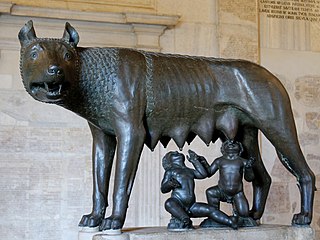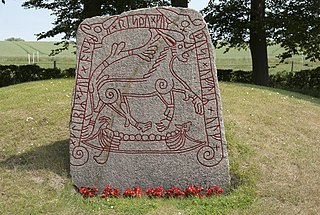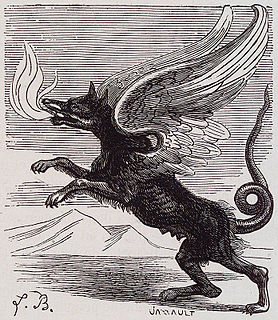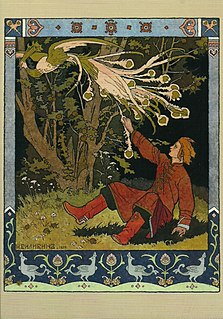 W
WThe wolf is a common motif in the foundational mythologies and cosmologies of peoples throughout Eurasia and North America. The obvious attribute of the wolf is its nature of a predator, and correspondingly it is strongly associated with danger and destruction, making it the symbol of the warrior on one hand, and that of the devil on the other. The modern trope of the Big Bad Wolf is a development of this. The wolf holds great importance in the cultures and religions of the nomadic peoples, both of the Eurasian steppe and North American Plains.
 W
WAnubis or Inpu, Anpu in Ancient Egyptian is the Greek name of the god of death, mummification, embalming, the afterlife, cemeteries, tombs, and the Underworld, in ancient Egyptian religion, usually depicted as a canine or a man with a canine head. Archeologists have identified Anubis's sacred animal as an Egyptian canid, the African golden wolf. The African wolf was formerly called the "African golden jackal", until a 2015 genetic analysis updated the taxonomy and the common name for the species. As a result, Anubis is often referred to as having a "jackal" head, but this "jackal" is now more properly called a "wolf".
 W
WAsena is the name of a she-wolf associated with the Oghuz Turkic foundation myth. The ancestress of the Göktürks is also a she-wolf, mentioned yet unnamed in two different "Wolf Tales" recorded by Chinese chroniclers.
 W
WBlaise of Sebaste was a physician and bishop of Sebastea in historical Armenia who is venerated as a Christian saint and martyr.
 W
WThe Boy Who Cried Wolf is one of Aesop's Fables, numbered 210 in the Perry Index. From it is derived the English idiom "to cry wolf", defined as "to give a false alarm" in Brewer's Dictionary of Phrase and Fable and glossed by the Oxford English Dictionary as meaning to make false claims, with the result that subsequent true claims are disbelieved.
 W
WThe Capitoline Wolf is a bronze sculpture depicting a scene from the legend of the founding of Rome. The sculpture shows a she-wolf suckling the mythical twin founders of Rome, Romulus and Remus. According to the legend, when King Numitor, grandfather of the twins, was overthrown by his brother Amulius in Alba Longa, the usurper ordered them to be cast into the Tiber River. They were rescued by a she-wolf that cared for them until a herdsman, Faustulus, found and raised them.
 W
WFenrir or Fenrisúlfr, also referred to as Hróðvitnir ("fame-wolf") and Vánagandr, or Vanargand, is a monstrous wolf in Norse mythology. Fenrir, together with Hel and the World Serpent, is a child of Loki and giantess Angrboða. He is attested in the Poetic Edda, compiled in the 13th century from earlier traditional sources, and the Prose Edda and Heimskringla, written in the 13th century by Snorri Sturluson. In both the Poetic Edda and Prose Edda, Fenrir is the father of the wolves Sköll and Hati Hróðvitnisson, is a son of Loki and is foretold to kill the god Odin during the events of Ragnarök, but will in turn be killed by Odin's son Víðarr.
 W
WGrey wolf is a sacred animal and national symbol in Turkic and Mongol mythology.
 W
WThe Wolf of Gubbio was a wolf who, according to the Fioretti di San Francesco, terrorized the Umbrian city of Gubbio until he was tamed by St. Francis of Assisi acting on behalf of God. The story is one of many in Christian narrative that depicts saints exerting influence over animals and nature, a motif common to hagiography.
 W
WThe wolf has been widely used in many forms in heraldry during the Middle Ages. Though commonly reviled as a livestock predator and man-eater, the wolf was also considered a noble and courageous animal, and frequently appeared on the arms and crests of numerous noble families. It typically symbolised the rewards of perseverance in long sieges or hard industry.
 W
WSaint Hervé, also known as Harvey, Herveus, Houarniaule, or Huva, was a sixth-century Breton saint. Along with Saint Ives, he is one of the most popular of the Breton saints. He was born in Guimiliau (Gwimilio).
 W
WThe Iron Wolf is a mythical character from a medieval legend of the founding of Vilnius, the capital city of the old Grand Duchy of Lithuania and modern Republic of Lithuania. First found in the Lithuanian Chronicles, the legend shares certain similarities with the Capitoline Wolf and possibly reflected Lithuanian desire to showcase their legendary origins from the Roman Empire. The legend became popular during the era of Romantic nationalism. Today Iron Wolf is one of the symbols of Vilnius and is used by sports teams, Lithuanian military, scouting organizations, and others.
 W
W"Little Red Riding Hood" is a European fairy tale about a young girl and a Big Bad Wolf. Its origins can be traced back to the 10th century to several European folk tales, including one from Italy called The False Grandmother. The two best known versions were written by Charles Perrault and the Brothers Grimm.
 W
WLupercalia was an ancient, possibly pre-Roman pastoral annual festival, observed in the city of Rome from the 13th to the 15th of February to avert evil spirits and purify the city, releasing health and fertility. Lupercalia was also called dies Februatus, after the instruments of purification called februa, which gave February (Februarius) its name.
 W
WIn demonology, Marchosias is a great and mighty Marquis of Hell, commanding thirty legions of demons. In the Ars Goetia, the first book of The Lesser Key of Solomon, he is depicted as a wolf with gryphon's wings and a serpent's tail, spewing fire from his mouth, but at the request of the magician he may take the form of a man. He is a strong fighter and gives true answers to all questions, and is very faithful to the magician in following his commands. Before his fall he belonged to the angelic order of Dominations, and when he was bound by Solomon he told him that after 1,200 years he hoped to return to Heaven.
 W
WGeorgia is the Western exonym for the country in the Caucasus natively known as Sakartvelo. The Russian exonym is Gruziya, while in Armenian it is Vrastan.
 W
WRaijū is a legendary creature from Japanese mythology.
 W
W"Throw to the wolves" is an English metaphorical idiom, meaning to sacrifice someone to save or benefit oneself or one's group. "Throw under the bus" is a more modern equivalent. "Throw to the wolves" is also sometimes used more generally to describe abandoning someone for any reason, cognate with "throw to the lions" and "throw to the dogs", which also derive from the supposedly man-eating appetites of a beast, or "kick to the curb".
 W
W"Tsarevich Ivan, the Firebird and the Gray Wolf" is a Russian fairy tale collected by Alexander Afanasyev in Russian Fairy Tales.
 W
WIn mythology and literature, a werewoman or were-woman is a woman who has taken the form of an animal through a process of lycanthropy. The use of the word "were" refers to the ability to shape-shift but is, taken literally, a contradiction in terms since in Old English the word "wer" means man. This would mean it literally translates to "man-woman".
 W
W"The Wolf and the Seven Young Goats" is a fairy tale collected by the Brothers Grimm and published in Grimm's Fairy Tales. It is of Aarne-Thompson type 123.